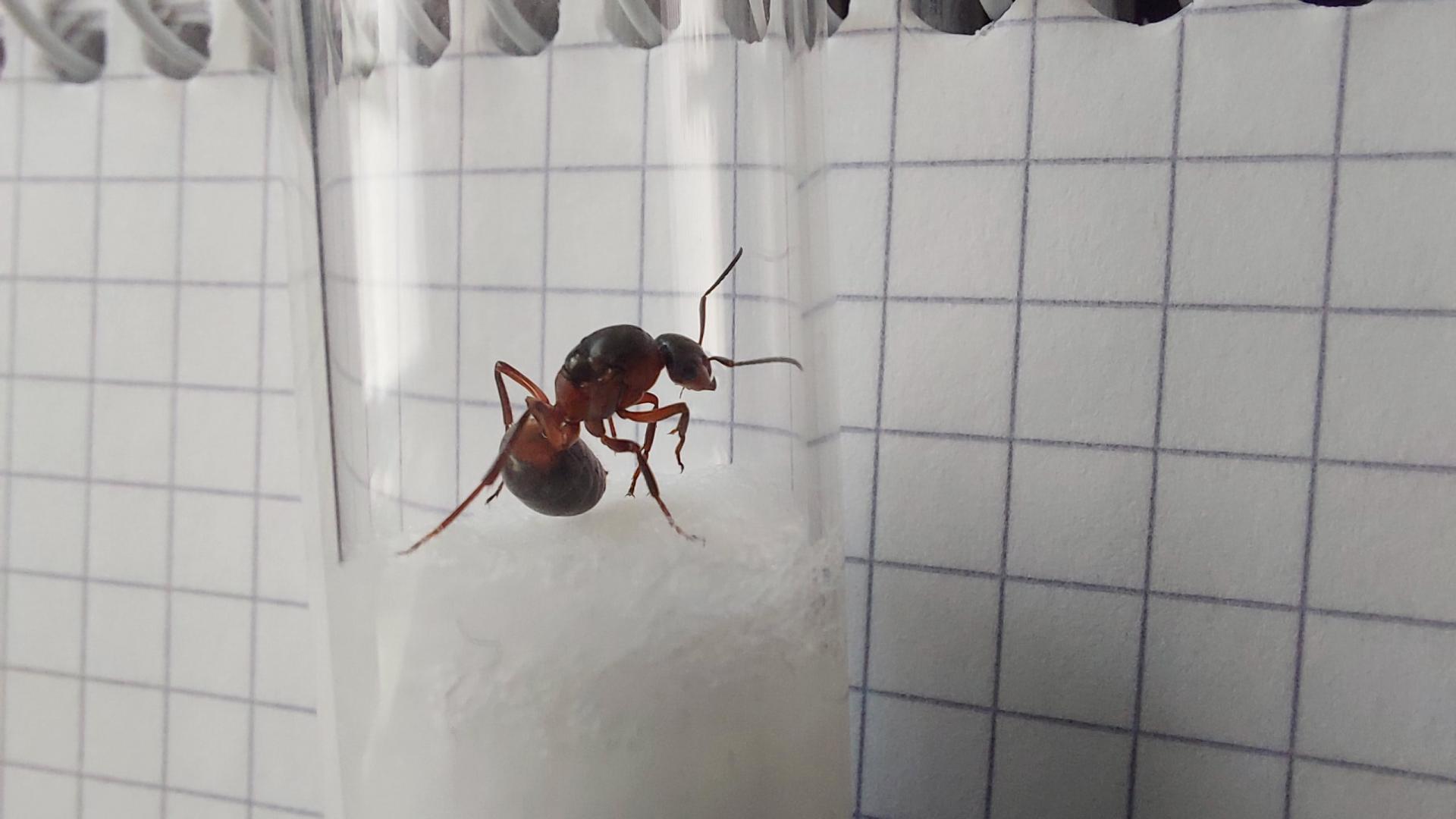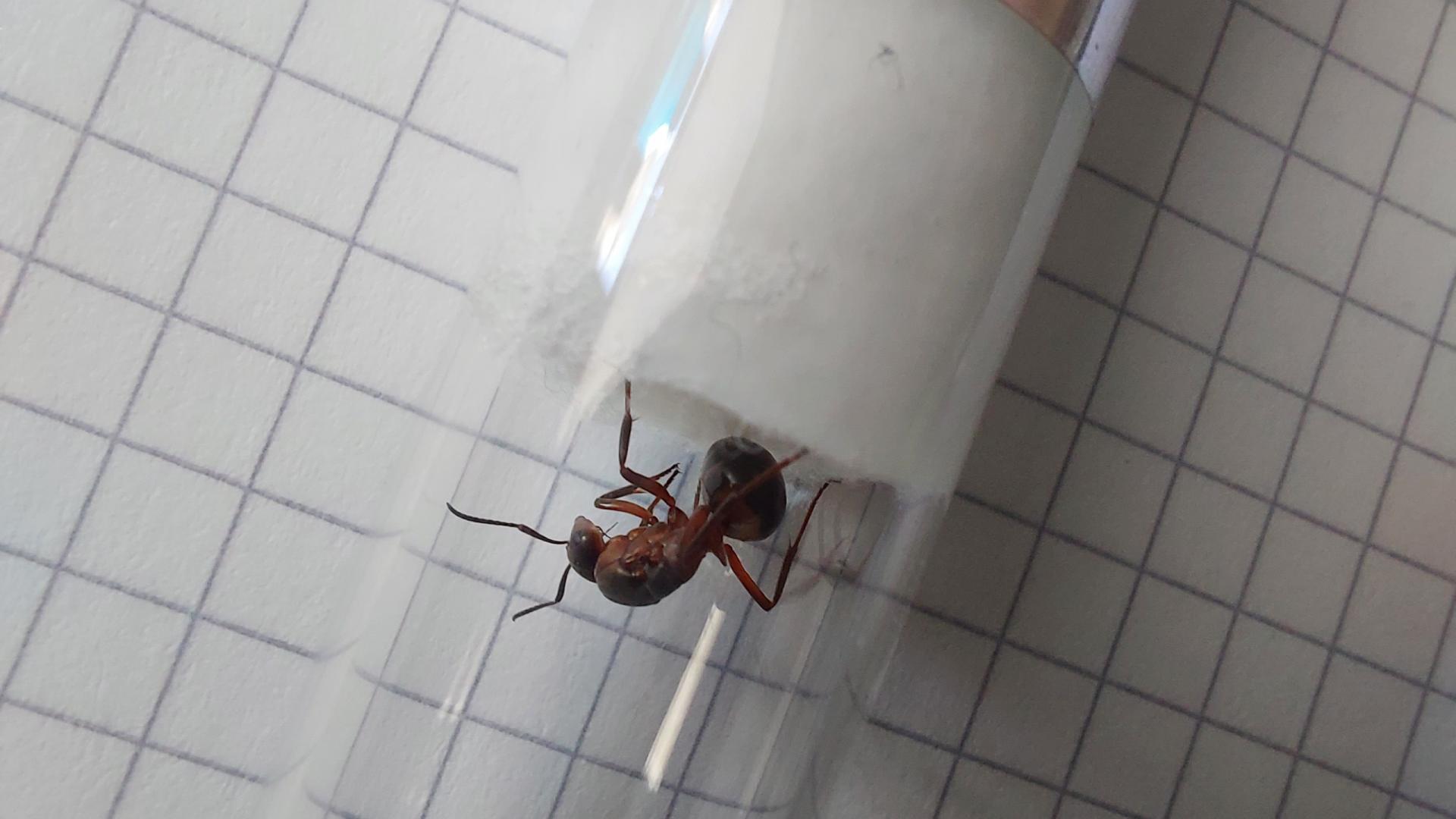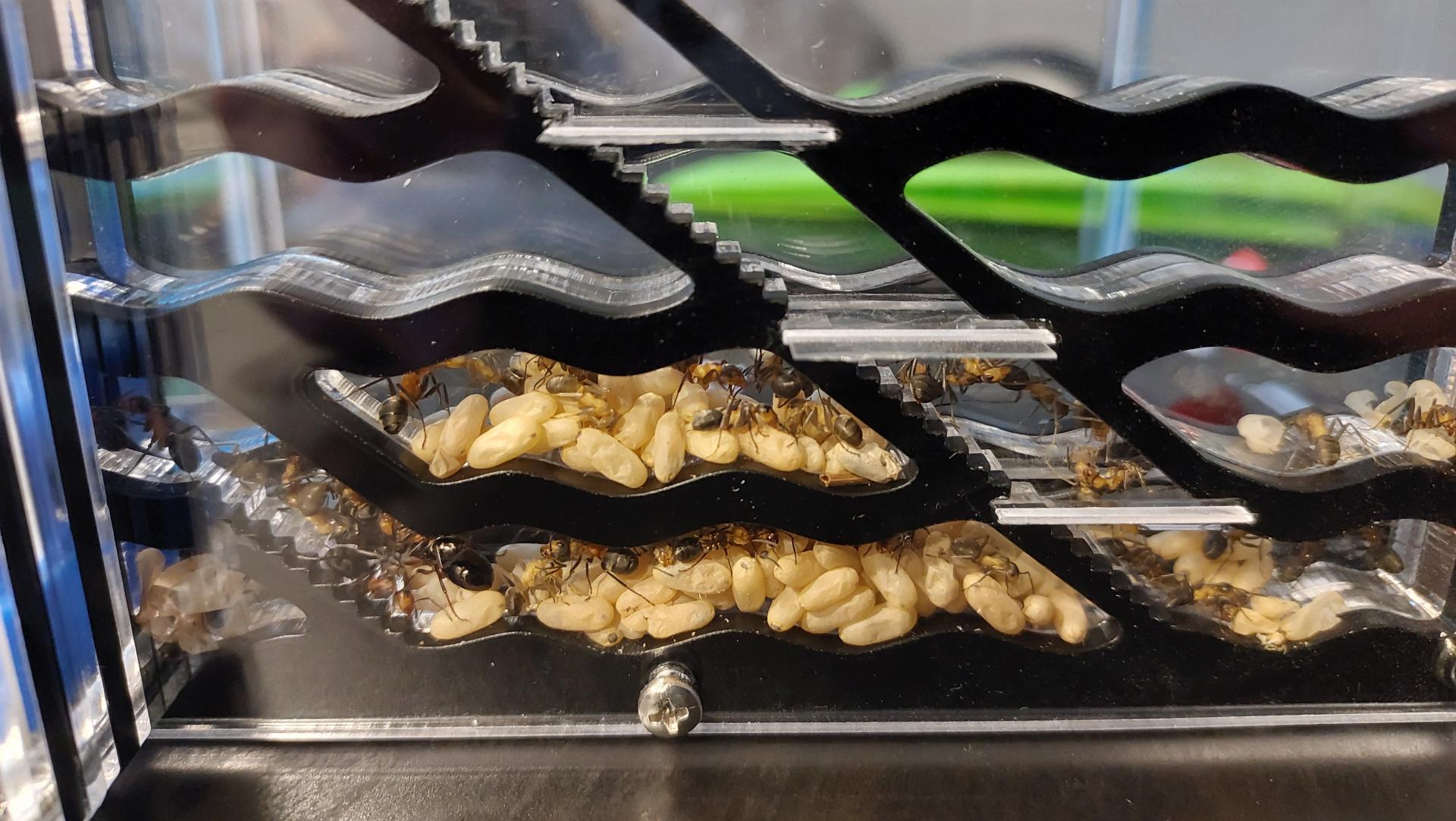If someone knows what species is it, is it hard to raise them and do they need any help before first workers? Because the body isn't that big.





Keeping:
3x - S. molesta (colonies and single queen) 1x - C. nearcticus (founding but no eggs) ![]() New!
New!
1x - C. chromaiodes (colony) 1x - C. subbarbatus (founding)
1x - F. subsericea (founding) 1x - T. sessile (mega colony)
3x - P. imparis (colonies)
2x - L. neoniger (founding)
Check out my C. nearcticus journal here: https://www.formicul...cticus-journal/
Check out my C. chromaiodes journal here: https://www.formicul...aiodes-journal/
Formica rufa either joins a pre-existing nest or is parasitic to formica fusca and formica cunicularia. I suggest you seek out nests of these species and take their callows(a recently enclosed worker) to put in her testube.
Keeping:
3x - S. molesta (colonies and single queen) 1x - C. nearcticus (founding but no eggs) ![]() New!
New!
1x - C. chromaiodes (colony) 1x - C. subbarbatus (founding)
1x - F. subsericea (founding) 1x - T. sessile (mega colony)
3x - P. imparis (colonies)
2x - L. neoniger (founding)
Check out my C. nearcticus journal here: https://www.formicul...cticus-journal/
Check out my C. chromaiodes journal here: https://www.formicul...aiodes-journal/
Thank you! It all makes sense, thank you for explanation. I hope I can find some pupae today as I will be in the area where I found queen.
I also heard about introducing host workers after putting them in a freezer for 60-120 seconds. Then while they recover, put them into the test tube so the queen gets used to them and they can't harm her, hopefully even forget their past scent and accept her.
Is it possible to start without pupae in case if I don't find any? If the queen gets some workers, is she going to start laying eggs?
Because I didn't have time to go find new workers yet, the queen was digging the exit cotton a lot, but I hope this delay didn't harm her.
Keeping:
3x - S. molesta (colonies and single queen) 1x - C. nearcticus (founding but no eggs) ![]() New!
New!
1x - C. chromaiodes (colony) 1x - C. subbarbatus (founding)
1x - F. subsericea (founding) 1x - T. sessile (mega colony)
3x - P. imparis (colonies)
2x - L. neoniger (founding)
Check out my C. nearcticus journal here: https://www.formicul...cticus-journal/
Check out my C. chromaiodes journal here: https://www.formicul...aiodes-journal/
I found one nest but couldn't get close to it. Only found workers, no pupae. I drowned them until they are unconscious and then separated into single containers. Hopefully they forget their nest smell and accept the new queen when I try to add them.
To my knowledge, Formica pratensis queens are the most easily recognizable of the rufa-complex species — pratensis queens have an opaque, matte gaster, while other species' queens are at least somewhat shiny on the gaster. I'm inclined against pratensis here since the gaster appears a bit shiny in the second photo, although it doesn't appear shiny in the first one so a photo of the gaster with clearer lighting may help. F. rufa may be the most common in the region, but there are others, especially F. polyctena which can be very hard to separate from rufa.
I found one nest but couldn't get close to it. Only found workers, no pupae. I drowned them until they are unconscious and then separated into single containers. Hopefully they forget their nest smell and accept the new queen when I try to add them.
Yep this should take about a week, during which you should definitely feed the queen plenty of sugar-water and a bit of protein. A way to find pupae is actually to place a slab rock on top of the nest, and they'll eventually assimilate it into a chamber, and place callow workers and pupae there, where it's nice and warm! Then you can just lift off the rock and take what you'd like! Apparently this works, but I've never tried this myself. I'd suggest you also integrate them together with the queen, if they're mature workers, via the refrigeration method, which will calm them all down during the process. I hope this colony works out for you!
Currently raising:
Manica invidia (1 queen + ~30 workers)
Lasius niger (single queen + ~200+ workers)
Lasius neoniger (2 single queen + brood)
Lasius neoniger (1 queen + worker, more on the way!)
Tetramorium immigrans (1 queen + ~1200 workers)
The gaster is shiny. Here are a couple more angles of the queen:
Nice! Well done, and glad it worked! Queen should begin laying her eggs very soon, and you'll be fine from there!
Currently raising:
Manica invidia (1 queen + ~30 workers)
Lasius niger (single queen + ~200+ workers)
Lasius neoniger (2 single queen + brood)
Lasius neoniger (1 queen + worker, more on the way!)
Tetramorium immigrans (1 queen + ~1200 workers)
A little update on the colony: I found and collected a bit of pupae from a F. Rufa nest. I added a few to the queen and a few left with workers.
Today queen opened 3 pupae and now the colony has 3 healthy workers. There is still a lot of pupae which they hopefully open soon so the queen starts laying eggs.
Glad to hear that your colony is doing well! The best part about parasitic Formica is the fact that you don't need already existing workers to enclose the brood like parasitic Lasius. Like what Stubyvast mentioned, it will only take a couple days (or at least a week) for her to lay some eggs and then you can start treating them like a normal colony. Good luck and I hope your colony does at it's best!
Keeping:
3x - S. molesta (colonies and single queen) 1x - C. nearcticus (founding but no eggs) ![]() New!
New!
1x - C. chromaiodes (colony) 1x - C. subbarbatus (founding)
1x - F. subsericea (founding) 1x - T. sessile (mega colony)
3x - P. imparis (colonies)
2x - L. neoniger (founding)
Check out my C. nearcticus journal here: https://www.formicul...cticus-journal/
Check out my C. chromaiodes journal here: https://www.formicul...aiodes-journal/
Thanks! I was gradually adding more pupae into the test tube because I found quite a lot in the small piece of dirt I took. She has around 18-20 workers already and has even more brood, so I moved her into a formicarium because they didn't have enough space in the test tube.
I even saw her doing the motion with her gaster like she lays eggs, so maybe she has some already. Hopefully I can see better after they organize all the pupae in the rooms
Good luck with her! I also have some parasitic Formica queens with pupae. The fact they accept pupae makes them a lot more convenient to found than parasitic Lasius who need adult workers. Will you be making a journal for her? I will follow.
"God made..... all the creatures that move along the ground according to their kinds (including ants). And God saw that it was good. Genesis 1:25 NIV version
Keeping:
Formica cf. pallidefulva, cf. incerta, cf. argentea
Formica cf. aserva, cf. subintegra
Myrmica sp.
Lasius neoniger, brevicornis
That's great! Did your queens already unpack the first workers? I think I will just post some updates in this same thread occasionally.
Right now they are about 50 workers in and still have a lot of pupae left. They finished drinking a big drop of honey and are also eating a small piece of boiled chicken I gave them. It's kinda hard to get a photo without reflections in a vertical formicarium, but here is one.

Man that is a loot of pupae! That should keep 'em going for a long time on just host workers alone! Well done.
Good luck with her! I also have some parasitic Formica queens with pupae. The fact they accept pupae makes them a lot more convenient to found than parasitic Lasius who need adult workers. Will you be making a journal for her? I will follow.
Yeah I've always wanted to keep Citronella ants, because of their distinctive yellow color, but yes, difficult to start-up. I assume you would just collect a few callow from the host Lasius nest, and, since they have a very indistinct nest smell, they can easily accept the parasitic queen (especially if you give the queen a little sample of dead host worker, just so she can lather up the scent).
Currently raising:
Manica invidia (1 queen + ~30 workers)
Lasius niger (single queen + ~200+ workers)
Lasius neoniger (2 single queen + brood)
Lasius neoniger (1 queen + worker, more on the way!)
Tetramorium immigrans (1 queen + ~1200 workers)
0 members, 1 guests, 0 anonymous users